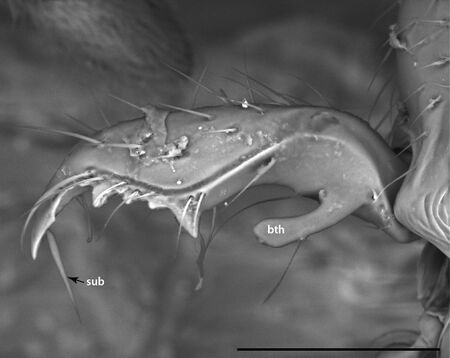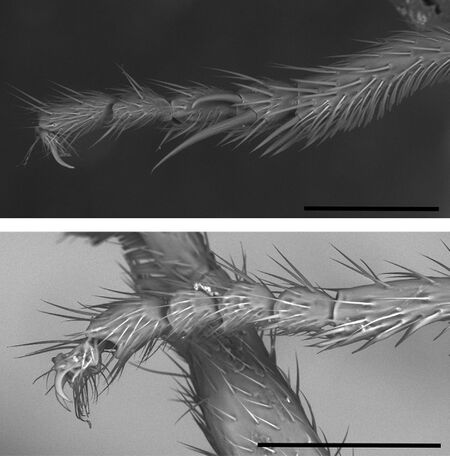Leptanilla belantan
| Leptanilla belantan | |
|---|---|
| Scientific classification | |
| Kingdom: | Animalia |
| Phylum: | Arthropoda |
| Class: | Insecta |
| Order: | Hymenoptera |
| Family: | Formicidae |
| Subfamily: | Leptanillinae |
| Tribe: | Leptanillini |
| Genus: | Leptanilla |
| Species: | L. belantan |
| Binomial name | |
| Leptanilla belantan Griebenow, 2024 | |
Photo Gallery
Identification
The worker of Leptanilla belantan is closest to that of Leptanilla judaica and Leptanilla ujjalai in appearance. Like L. ujjalai, L. belantan possesses an enlarged, truncate proximal tooth on the mandible, which in the latter species is bent distally; L. belantan differs from L. ujjalai in not having a serrated subpetiolar process and in the apex of the frontoclypeal process being emarginate, rather than entire. Castaneous coloration and lack of a meso-metapleural furrow set L. belantan apart from L. judaica. The gyne habitus of L. belantan is nearest to Leptanilla escheri, differing in the elongation of the masticatory margin and the complete absence of ommatidia.
The mandible of the gyne of L. belantan differs from the falcate facies observed in all other Leptanilla gynes, with the masticatory margin being longer than the basal margin. The gyne mandible in L. belantan therefore converges with the synapomorphic condition of the Poneroformicines (Richter et al. 2022).
Keys including this Species
Distribution
Latitudinal Distribution Pattern
Latitudinal Range: 3.4° to 3.4°.
| North Temperate |
North Subtropical |
Tropical | South Subtropical |
South Temperate |
- Source: Griebenow, 2024
Distribution based on Regional Taxon Lists
Indo-Australian Region: Malaysia (type locality).
Distribution based on AntMaps
Distribution based on AntWeb specimens
Check data from AntWeb
Countries Occupied
| Number of countries occupied by this species based on AntWiki Regional Taxon Lists. In general, fewer countries occupied indicates a narrower range, while more countries indicates a more widespread species. |

|
Estimated Abundance
| Relative abundance based on number of AntMaps records per species (this species within the purple bar). Fewer records (to the left) indicates a less abundant/encountered species while more records (to the right) indicates more abundant/encountered species. |

|
Biology
Castes
Nomenclature
The following information is derived from Barry Bolton's Online Catalogue of the Ants of the World.
- belantan. Leptanilla belantan Griebenow, 2024: 95, figs. 6-8 (w.q.) MALAYSIA (Selangor).
Type Material
- Holotype. Malaysia – Selangor • 1 worker; Genting Highlands, below Sri Layan; 1.iv.1981; W. L. Brown leg.; hill forest, red-rotten wood; MCZ:Ent:00728278. MCZC
- Paratypes. Malaysia – Selangor • 1 gyne; same data as for holotype; MCZ:Ent:00728275; MCZC • 3 worker, same data as for holotype; MCZ:Ent:00728276, MCZ:Ent:00728277, MCZ:Ent:00793731; MCZC • 2 worker, same data as for holotype; MCZ:Ent:00793729, MCZ:Ent:00793730; UCDC.
Taxonomic Notes
It is quite possible that the specimens identified as Leptanilla escheri and mentioned by Hölldobler et al. (1989) in fact belong to this species, since these also originated in peninsular Malaysia, although this speculation is unprovable because the repository of those specimens was not reported. It is also possible but unconfirmable that the undescribed Leptanilla species portrayed in Bolton (1990b: figs 8–11) corresponds to L. belantan.
As with L. escheri, the placement of L. belantan in the Leptanilla thai species group must be regarded with some caution until this hypothesis can be tested with phylogenomic inference. It is conceivable that L. belantan instead belongs to the Leptanilla havilandi species group, since the worker caste of the two clades are at times distinguishable only by phenetic minutiae such as sculpturation. Unlike its putative close relatives within the Leptanilla thai species group, L. belantan exists in parapatry with the Leptanilla havilandi species group, allowing for the possibility that this species belongs to the latter clade.



